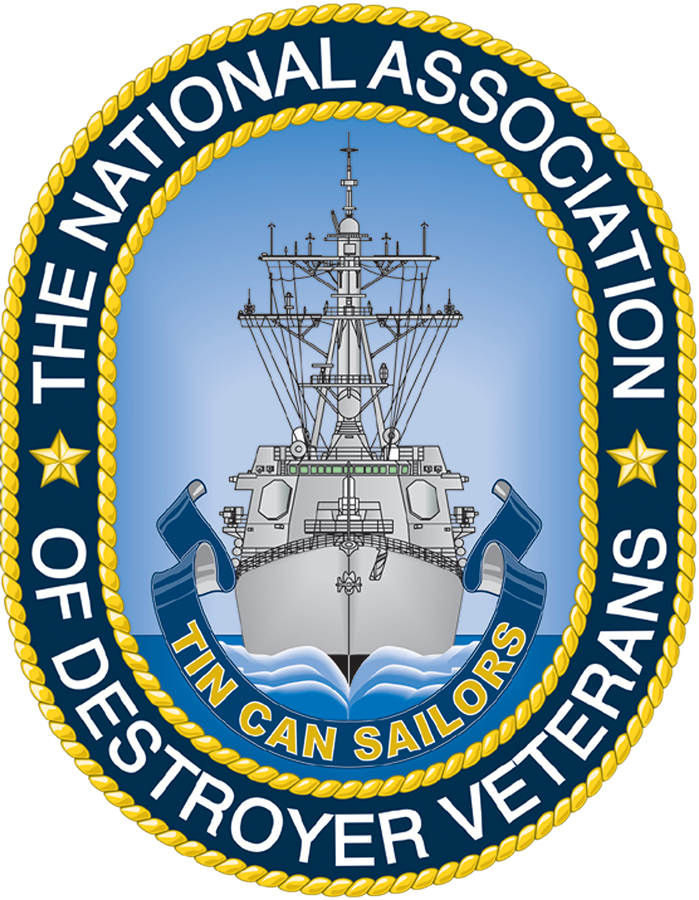A Tin Can Sailors Destroyer History
USS BUCK DD-420
The Tin Can Sailor, April 2000
Naval hero James Buck served during the Civil War. Despite severe wounds, he remained at the wheel of the steamer BROOKLYN throughout an eight-hour battle on the Mississippi. The destroyer bearing his name was launched on 22 May 1939 and was commissioned on 15 May 1940. Except for brief service with the Pacific Fleet in the spring of 1941, she operated as part of the Atlantic Fleet, serving on convoy escort duty between the U.S. and Iceland and along the eastern seaboard. She continued on escort duty after the U.S. entered the war and steamed between the East Coast and ports in Newfoundland, Iceland, Northern Ireland, North Africa, and the Caribbean.
On 22 August 1942, during one of these crossings, the BUCK was screen flagship for a convoy steaming east out of Halifax, Nova Scotia. At 1730, the sonar on the troopship LETITIA registered a contact. The destroyers SWANSON and INGRAHAM were sent to investigate and could only surmise that the LETITIA’s sonar man had mistaken a school of porpoises for an enemy sub. With the danger past, the three ships headed back to their positions with the convoy. By that time, a dense fog had rolled in reducing visibility to thirty yards. Ordered to escort the LETITIA to her proper station, the BUCK was crossing through the column at 2225, when a ship loomed out of the fog. Before her lookout could shout a warning, the transport AWATEA plowed into the destroyer’s starboard quarter. The impact cut about two thirds through the BUCK’s fantail, broke her keel, and dislodged a 300-pound depth charge, which exploded, further damaging the ship’s fantail and propellers. Seven of the BUCK’s crew died as a result of the collision and ensuing explosion.
The disastrous chain of events had not ended, however. Moments after the BUCK careened away from the AWATEA, her crew was shaken by a tremendous explosion in the general direction of the oiler CHEMUNG. They immediately assumed the oiler had been torpedoed. Not so. Steaming through the blinding fog to investigate the collision of the BUCK and AWATEA, the INGRAHAM had run directly into the path of the CHEMUNG, which tore into the smaller ship. The collision set off her depth charges causing a massive internal explosion. The CHEMUNG backed away, her bow scorched by the blast and several of her crew injured, but any attempt to rescue the crew of the INGRAHAM was out of the question. There was no getting close to the blazing ship. Only ten sailors and one officer escaped.
Meanwhile, the BUCK was floundering with both propellers out of commission. Within a few hours, the port propeller dropped off and eventually, the fantail section, held on only by lines and wires, had to be allowed to sink before it damaged the hull. Taken in tow first by the CHEMUNG and then by the CHEROKEE (AT-66), the BUCK finally reached Boston. Upon completion of repairs in November, she returned to escort duty until June 1943.
Her assignment that month took her to North Africa for patrol duty off Tunisia and Algeria. A month later, as the flagship of Destroyer Squadron 13 with Task Force 86, she participated in the invasion of Sicily. On the morning of 10 July, her squadron, which included the WOOLSEY, LUDLOW, EDISON, BRISTOL, WILKES, NICHOLSON, SWANSON, and ROE, joined the cruisers BROOKLYN and BIRMINGHAM in shelling shore batteries at Licata and fighting off Axis air attacks. The BUCK continued her bombardment, screening, and patrol duties until August. Then, on the evening of 2 August, she and the NICHOLSON were detached to escort a convoy of six liberty ships from Sicily to Algeria. En route, the BUCK’s radar picked up a surface vessel about 5,500 yards distant. When the “pip” suddenly disappeared from the radar screen, her skipper, Lieutenant Commander M. J. Klein, figured they’d surprised a submarine and ordered a search. By 2300, the BUCK had closed to 700 yards, and her sonar confirmed that they did, indeed, have a submarine. During the hunt, Klein called for three depth charge attacks, which finally brought the enemy sub to the bottom, and the BUCK moved in to pick up forty-five survivors from what they learned was the Italian submarine ARGENTO.
After escorting a convoy to the U.S., the BUCK returned to the Mediterranean in late September 1943 for the invasion and occupation of Italy. During the night of 8/9 October 1943, she was on duty patrolling the approaches to Salerno. Shortly after midnight, she made radar contact and all hands prepared to hunt the enemy down. The enemy, however, already had targeted the BUCK. Two torpedoes tore into her bow and the subsequent explosions caused such devastation that the ship had to be abandoned within three minutes after she was hit. She sank a minute later taking some 150 of her crew with her. Among those lost was her captain. Ninety-seven of her crew were pulled from the water by the GLEAVES (DD-423) and the British LCT-170.
